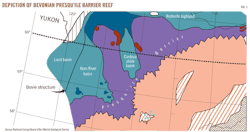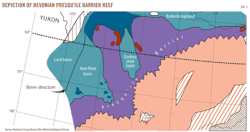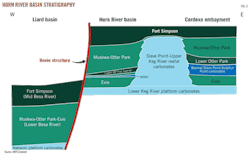The ultimate potential for marketable unconventional shale gas in the Horn River basin of Northeast British Columbia is 78 tcf, said a report by Canada's National Energy Board and the BC Ministry of Energy and Mines.
The volume consists of 3 tcf of discovered resources and 75 tcf of undiscovered resources. The report is the first publicly released probability-based resource assessment of a Canadian shale basin. Horn River is part of the Western Canada Sedimentary basin.
The 78 tcf volume is more than double a previous assessment of gas resources in the province.
By way of placing the Horn River figures in context, the NEB estimated that 197 tcf of conventional and unconventional natural gas remain in the WCSB, although this number does not take into account known but as yet unassessed unconventional gas resources.
The estimate of total remaining conventional and unconventional natural gas in Northeast BC available for future demand is 109 tcf. That includes 78 tcf of shale gas and 31 tcf of remaining natural gas resources identified in a joint assessment of conventional natural gas resources in Northeast BC. The NEB and the ministry released the conventional gas assessment in 2006.
The new report on unconventional gas resources puts forth the medium-case estimate of 78 tcf for Horn River shale gas as the most realistic scenario. However, the two agencies estimated Horn River shale gas potential to be in a range from 61 tcf to 96 tcf.
In the same report the agencies estimated remaining conventional gas potential at 78 tcf in Alberta, 4 tcf in Saskatchewan, and 6 tcf in the southern territories. They did not estimate unconventional potential in those three areas.
Northeast BC now holds about 55% of the reported ultimate remaining conventional and unconventional natural gas resources in the WCSB, and the remaining Horn River basin resources can support high drilling levels for many years in the province, the agencies said.
They noted that a number of other unconventional natural gas plays in BC and elsewhere in Canada, if developed, could substantially increase the resources available for Canadian use and export. The agencies intend to assess these BC plays as time, data, and resources allow. The NEB also intends to assess unconventional plays elsewhere in the country.
By further comparison, the Canadian agencies compared Horn River's 78 tcf of marketable to 262 tcf for the Marcellus shale, 251 tcf for the Haynesville shale, 44 tcf for the Barnett shale, and 41.6 tcf for the Fayetteville shale. Figures for the US shales came from the US Department of Energy.
Horn River geology
During the Middle Devonian period, the agencies said, the Presqu'ile barrier reef extended from Alberta through BC and into the Yukon and Northwest Territories.
The reef was an area of shallow, well-circulated sea water where fine calcite mud and the skeletons of reef growing organisms were deposited and converted to limestone and dolostone after they were buried. Clays, fine siliceous (silica-rich) muds, and organic matter from dead plankton were deposited in the deeper, poorly oxygenated waters of the Horn River basin to the west and in the Cordova embayment to the east and were converted over time into shale deposits.
In both areas, the shales have been subdivided into, from the bottom up, the Evie, Otter Park, and Muskwa shales and contain enough organic material to have generated natural gas. Some of the gas migrated into the Presqu'ile barrier and was locally trapped in conventional oil and gas pools.
The Evie shale consists of dark grey to black, radioactive, organic-rich, pyritic, variably calcareous (calcite-rich), and siliceous shale. The unit is characterized on well logs by relatively high gamma ray readings and high resistivity. The uppermost part of the unit includes more silt and generally has lower radioactivity and resistivity.
In the Horn River basin, the Evie is over 75 m thick immediately west of the Presqu'ile barrier reef and thins westward to less than 40 m thick in the vicinity of the Bovie Lake structure (western margin of the basin). The Evie shale overlies limestones and dolostones of the Lower Keg River formation.
The Otter Park shale reaches a maximum thickness of over 270 m in the southeast corner of the Horn River basin, where it consists of medium to dark grey calcareous shale with lower radioactivity and resistivity on well logs than the Evie and Muskwa shales. The Otter Park thins to the north and west and begins to include radioactive siliceous black shale beds, the agencies said.
The Muskwa consists of grey to black, radioactive, organic-rich, pyritic, siliceous shales, and is characterized on well logs by high gamma ray readings and high resistivity. It has a gradational contact with the overlying silt-rich shales of the Fort Simpson formation.
In the Horn River basin, the Muskwa is 30 m thick adjacent to the Presqu'ile barrier reef and thickens westward to over 60 m in the vicinity of the Bovie Lake structure on the western side of the basin. However, the Muskwa thins considerably where the Otter Park thickness reaches its maximum in the southeast corner of the Horn River basin.
Unlike the underlying shales, the Muskwa is not restricted to the Horn River basin but thins and extends over the top of the barrier reef and is present through the rest of Northeast BC. It is also stratigraphically equivalent to the Duvernay shale, which extends over much of Alberta.
The agencies estimated 25 tcf of gas marketable from 132 tcf in place in the Muskwa and 24 tcf marketable from 159 tcf in place in Otter Park. They estimated 78 tcf of gas marketable from 448 tcf in place in the overall Horn River basin.
Given the lack of long-term production from the Horn River basin, free gas recovery factors are highly uncertain. Recovery factors varied for each shale, but most likely values were 15-25%.
The agencies also considered the level of impurities to be removed to elevate the gas to pipeline quality and how much gas would be extracted as fuel gas to transport and process the raw gas. The amount of impurities in Horn River basin shale gas appears to vary by shale, with some wells as low as 8% and others as high as 19%, dominantly consisting of carbon dioxide. The impurities increase with depth.
More Oil & Gas Journal Current Issue Articles
More Oil & Gas Journal Archives Issue Articles
View Oil and Gas Articles on PennEnergy.com



